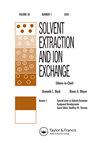磷酸三丁酯/磷酸三异戊酯-十二烷体系在硝酸介质中循环辐照行为的比较
IF 2.1
4区 化学
Q3 CHEMISTRY, MULTIDISCIPLINARY
引用次数: 1
摘要
1.1γ辐照溶液的降解行为 M磷酸三丁酯(TBP)在正十二烷(n-DD)和1.1 M磷酸三异戊酯(TiAP)在负载硝酸和铀的n-DD中的循环进行比较,每次循环80kGy后回收降解的溶剂达5次循环。通过用稀硝酸汽提负载的金属,然后在每个循环后用碳酸钠进行碱洗来回收溶剂。随后,测量了回收溶剂的物理化学性质和金属萃取-保留性质。使用气相色谱和FT-IR光谱分析对回收的溶剂进行分析。在物理化学性质中,回收溶剂的界面张力在三次辐照后急剧下降,但测得的相分离时间变化不大。但是,萃取剂(TBP/TiAP)的浓度在再循环后显著降低。尽管从FT-IR分析中可以明显看出硝基化合物的形成,但在每个辐照循环后,回收有机相对金属的保留是相当的。重点比较了TiAP/n-DD和TBP/n-DD在酸负载和铀负载条件下的循环辐照行为。评估了循环次数,溶剂在回收后可以重复使用。GC分析表明,在铀负载条件下的循环辐照会在很大程度上导致萃取剂(TBP/TiAP)的降解。基于FT-IR分析,回收后会积累不易清洗的降解产物。图形摘要本文章由计算机程序翻译,如有差异,请以英文原文为准。
Comparison of Cyclic Irradiation Behavior of Tri-Butyl Phosphate / Tri-Iso-Amyl Phosphate-Dodecane System in Nitric Acid Medium
ABSTRACT The degradation behavior of gamma irradiated solution of 1.1 M tri-butyl phosphate (TBP) in n-dodecane (n-DD) and 1.1 M tri-iso-amyl phosphate (TiAP) in n-DD loaded with nitric acid and uranium were compared up to 5 cycles upon recycling of the degraded solvent after 80 kGy in each cycle. The solvent was recycled by stripping the loaded metal with dilute nitric acid followed by alkali wash using sodium carbonate after each cycle. Subsequently, the physico-chemical properties and the metal extraction – retention properties of the recycled solvent were measured. The recycled solvent was analyzed using gas chromatographic and FT-IR spectroscopic analysis. Among the physico-chemical properties the interfacial tension of the recycled solvent decreased drastically after three cycles of irradiation, but the variation in the measured phase separation time was not significant. But, the concentration of the extractant (TBP/TiAP) decreased significantly upon recycling. Though the formation of nitro compounds was obvious from FT-IR analysis, the metal retention by recycled organic phases were comparable after each cycle of irradiation. HIGHLIGHTS Cyclic irradiation behavior of TiAP/n-DD and TBP/n-DD was compared under acid loaded and uranium loaded condition. The number of cycles, the solvent can be reused upon recycling was evaluated. Cyclic irradiation under uranium loading condition leads to degradation of the extractant (TBP/TiAP) to a significant extent as evident from GC-analysis. Accumulation of unwashable degraded products takes place upon recycling based on FT-IR analysis. GRAPHICAL ABSTRACT
求助全文
通过发布文献求助,成功后即可免费获取论文全文。
去求助
来源期刊
CiteScore
4.40
自引率
5.00%
发文量
15
审稿时长
8.4 months
期刊介绍:
Solvent Extraction and Ion Exchange is an international journal that publishes original research papers, reviews, and notes that address all aspects of solvent extraction, ion exchange, and closely related methods involving, for example, liquid membranes, extraction chromatography, supercritical fluids, ionic liquids, microfluidics, and adsorption. We welcome submissions that look at: The underlying principles in solvent extraction and ion exchange; Solvent extraction and ion exchange process development; New materials or reagents, their syntheses and properties; Computational methods of molecular design and simulation; Advances in equipment, fluid dynamics, and engineering; Interfacial phenomena, kinetics, and coalescence; Spectroscopic and diffraction analysis of structure and dynamics; Host-guest chemistry, ion receptors, and molecular recognition.

 求助内容:
求助内容: 应助结果提醒方式:
应助结果提醒方式:


